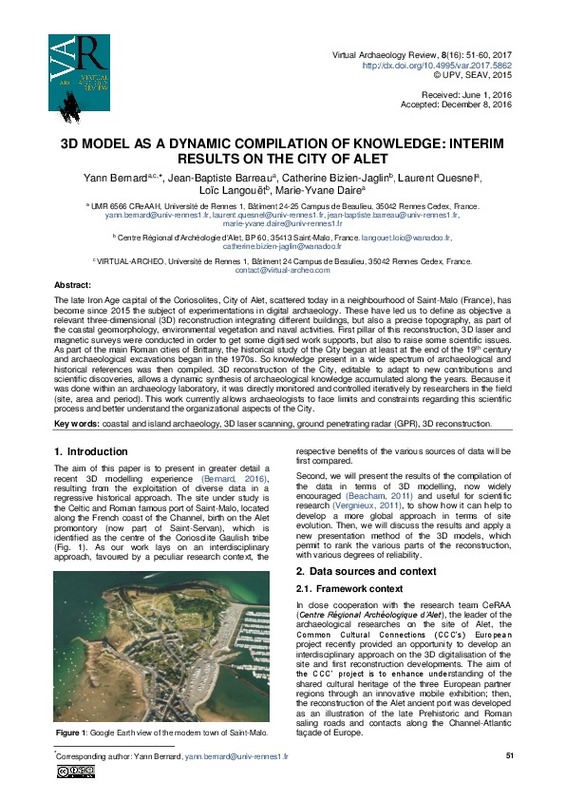JavaScript is disabled for your browser. Some features of this site may not work without it.
Buscar en RiuNet
Listar
Mi cuenta
Estadísticas
Ayuda RiuNet
Admin. UPV
3D model as a dynamic compilation of knowledge: interim results on the city of Alet
Mostrar el registro sencillo del ítem
Ficheros en el ítem
| dc.contributor.author | Bernard, Yann
|
es_ES |
| dc.contributor.author | Barreau, Jean-Baptiste
|
es_ES |
| dc.contributor.author | Bizien-Jaglin, Catherine
|
es_ES |
| dc.contributor.author | Quesnel, Laurent
|
es_ES |
| dc.contributor.author | Langouët, Loïc
|
es_ES |
| dc.contributor.author | Daire, Marie-Yvane
|
es_ES |
| dc.coverage.spatial | east=-2.025673999999981; north=48.649337; name=Sant-Maloù, França | |
| dc.date.accessioned | 2017-06-13T07:11:51Z | |
| dc.date.available | 2017-06-13T07:11:51Z | |
| dc.date.issued | 2017-05-22 | |
| dc.identifier.uri | http://hdl.handle.net/10251/82700 | |
| dc.description.abstract | [EN] The late Iron Age capital of the Coriosolites, City of Alet, scattered today in a neighbourhood of Saint-Malo( France), has become since 2015 the subject of experimentations in digital archaeology. These have led us to define as objective a relevant three-dimensional (3D)reconstruction integrating different buildings, but also a precise topography, aspart of the coastal geomorphology, environmental vegetation and naval activities. First pillar of this reconstruction, 3D laser and magnetic surveys were conducted in order to get some digitised work supports, but also to raise some scientific issues. As part of the main Roman cities of Brittany, the historical study of the City began at least at the end of the 19thcentury and archaeological excavations began in the 1970s. So knowledge present in a wide spectrum of archaeological and historical references was then compiled. 3D reconstruction of the City, editable to adapt to new contributions and scientific discoveries, allows a dynamic synthesis of archaeological knowledge accumulated along the years. Because it was done within an archaeology laboratory, it was directly monitored and controlled iteratively by researchers in the field (site, area and period). This work currently allows archaeologists to face limits and constraints regarding this scientific process and better understand the organizational aspects of the City. | es_ES |
| dc.description.sponsorship | The CCC’ project is co-funded by the Creative Europe Programme of the European Union. It is led by the MAT (Maritime Archaeology Trust, Southampton, UK) and involves the Prehistory Department of the Universtiy of Cantabria (Santander, Spain), and the CReAAH (Centre de Recherche en Archéologie, Archéosciences, Histoire, Rennes, France). We also want to thank the company ABEM France for the loan of the Stream EM multichannel GPR used in Alet. | |
| dc.language | Inglés | es_ES |
| dc.publisher | Universitat Politècnica de València | |
| dc.relation.ispartof | Virtual Archaeology Review | |
| dc.rights | Reconocimiento - No comercial - Sin obra derivada (by-nc-nd) | es_ES |
| dc.subject | Coastal and Island Archaeology | es_ES |
| dc.subject | 3D laser scanning | es_ES |
| dc.subject | Ground Penetrating Radar (GPR) | es_ES |
| dc.subject | 3D reconstruction | es_ES |
| dc.title | 3D model as a dynamic compilation of knowledge: interim results on the city of Alet | es_ES |
| dc.type | Artículo | es_ES |
| dc.date.updated | 2017-06-12T07:20:45Z | |
| dc.identifier.doi | 10.4995/var.2017.5862 | |
| dc.rights.accessRights | Abierto | es_ES |
| dc.description.bibliographicCitation | Bernard, Y.; Barreau, J.; Bizien-Jaglin, C.; Quesnel, L.; Langouët, L.; Daire, M. (2017). 3D model as a dynamic compilation of knowledge: interim results on the city of Alet. Virtual Archaeology Review. 8(16):51-60. https://doi.org/10.4995/var.2017.5862 | es_ES |
| dc.description.accrualMethod | SWORD | es_ES |
| dc.relation.publisherversion | https://doi.org/10.4995/var.2017.5862 | es_ES |
| dc.description.upvformatpinicio | 51 | es_ES |
| dc.description.upvformatpfin | 60 | es_ES |
| dc.type.version | info:eu-repo/semantics/publishedVersion | es_ES |
| dc.description.volume | 8 | |
| dc.description.issue | 16 | |
| dc.identifier.eissn | 1989-9947 | |
| dc.contributor.funder | European Commission |








